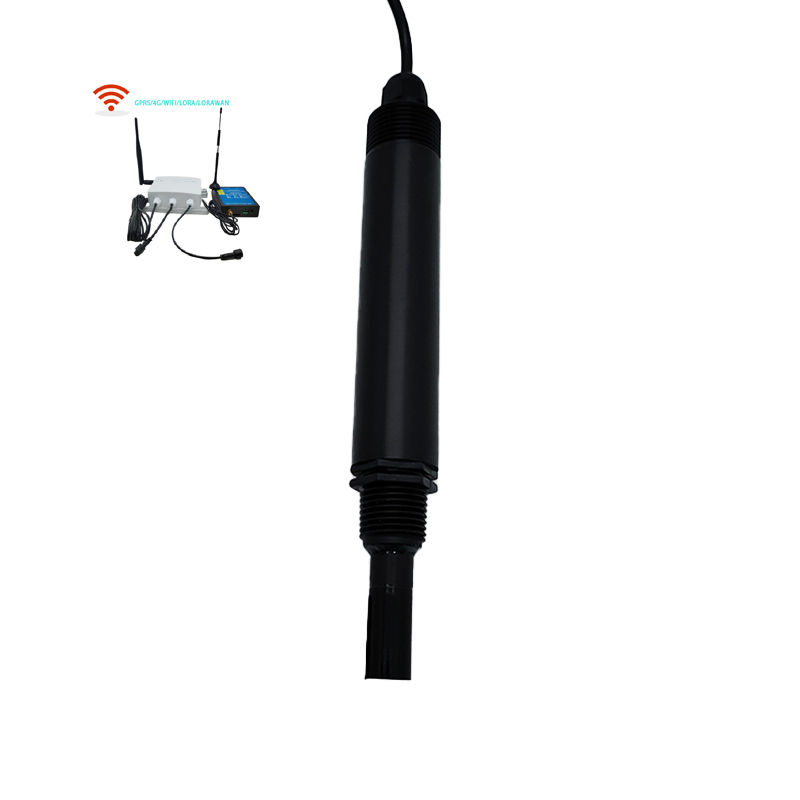Water EC sensors (electrical conductivity sensors) play a vital role in aquaculture by measuring the electrical conductivity (EC) of water, which indirectly reflects the total concentration of dissolved salts, minerals, and ions. Below are their specific applications and functions:
1. Core Functions
- Monitoring Water Salinity:
EC values are closely related to water salinity, helping determine whether the water is suitable for specific aquatic species (e.g., freshwater fish, marine fish, or shrimp/crabs). Different species have varying salinity tolerance ranges, and EC sensors provide real-time alerts for abnormal salinity levels. - Assessing Water Stability:
Changes in EC may indicate pollution, rainwater dilution, or groundwater intrusion, allowing farmers to take timely corrective actions.
2. Specific Applications
(1) Optimizing the Farming Environment
- Freshwater Aquaculture:
Prevents stress in aquatic life due to rising salinity (e.g., from waste buildup or feed residue). For example, tilapia thrive in an EC range of 500–1500 μS/cm; deviations may hinder growth. - Marine Aquaculture:
Monitors salinity fluctuations (e.g., after heavy rainfall) to maintain stable conditions for sensitive species like shrimp and shellfish.
(2) Feeding and Medication Management
- Feed Adjustment:
A sudden rise in EC may indicate excess uneaten feed, prompting reduced feeding to prevent water quality deterioration. - Medication Dosage Control:
Some treatments (e.g., salt baths) rely on salinity levels, and EC sensors ensure accurate ion concentration monitoring.
(3) Breeding and Hatchery Operations
- Incubation Environment Control:
Fish eggs and larvae are highly sensitive to salinity, and stable EC levels improve hatching rates (e.g., salmon eggs require specific EC conditions).
(4) Water Source Management
- Incoming Water Monitoring:
Checks the EC of new water sources (e.g., groundwater or rivers) to avoid introducing high-salinity or contaminated water.
3. Advantages and Necessity
- Real-Time Monitoring:
Continuous EC tracking is more efficient than manual sampling, preventing delays that could lead to losses. - Disease Prevention:
Imbalanced salinity/ion levels can cause osmotic stress in fish; EC sensors provide early warnings. - Energy and Resource Efficiency:
When integrated with automated systems (e.g., water exchange or aeration), they help reduce waste.
4. Key Considerations
- Temperature Compensation:
EC readings are temperature-dependent, so sensors with automatic temperature correction are essential. - Regular Calibration:
Electrode fouling or aging can skew data; calibration with standard solutions is necessary. - Multi-Parameter Analysis:
EC data should be combined with other sensors (e.g., dissolved oxygen, pH, ammonia) for comprehensive water quality assessment.
5. Typical EC Ranges for Common Species
| Aquaculture Species | Optimal EC Range (μS/cm) |
|---|---|
| Freshwater Fish (Carp) | 200–800 |
| Pacific White Shrimp | 20,000–45,000 (seawater) |
| Giant Freshwater Prawn | 500–2,000 (freshwater) |
By using EC sensors for precise monitoring, aquaculturists can significantly improve water quality management, reduce risks, and enhance productivity and profitability.
We can also provide a variety of solutions for
1. Handheld meter for multi-parameter water quality
2. Floating Buoy system for multi-parameter water quality
3. Automatic cleaning brush for multi-parameter water sensor
4. Complete set of servers and software wireless module, supports RS485 GPRS /4g/WIFI/LORA/LORAWAN
For more water sensor information,
please contact Honde Technology Co., LTD.
Email: info@hondetech.com
Company website: www.hondetechco.com
Tel: +86-15210548582
Post time: Aug-08-2025


